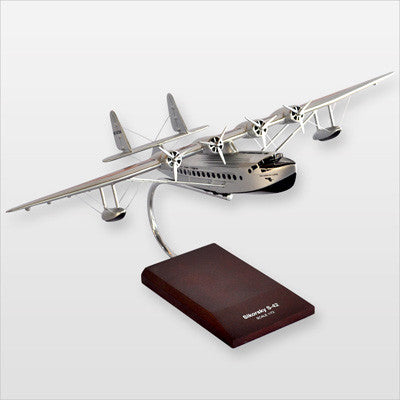Executive Series Boeing B-29 Superfortress "Doc" Mahogany Model
$ 219.95
Introducing the ready-to-ship Boeing B-29 mahoany model. This 1/72 scale model was handmade with precision and accuracy to produce the finest model that will be the centerpiece of your collection for years to come. This model is a perfect gift for pilots and aviation enthusiasts alike. Not too big or too small, this model features a wingspan of 23.75 inches and a length of 17 inches. This model features a very accurate paint scheme with realistic panel lines.
About this Model:
Your model will be delivered exactly as shown in the photographs with the exact same paint scheme. The stand shown in this photograph may vary or change with the model you receive. If you would like to change this model in any other way, please visit the Custom Model section of our website to commission a customized model to be built.
History of the Boeing B-29:
The Boeing B-29 was the most complex aircraft of World War II. It dwarfed other bombers, including its famous predecessor, the B-17 Flying Fortress. At 99 feet long, with a wing span of 141 feet, a B-29 weighed more than 120,000 pounds loaded. Its four Wright R-3350 engines could propel it to a maximum speed of more than 350 mph, and to altitudes topping 30,000 feet. The B-29 also featured pressurized crew compartments, a central fire control station directing 10 .50-caliber machine guns in remote-controlled turrets, analog fire control computers, and use of lightweight alloys throughout the aircraft. Because of its complexity, the B-29 was troublesome to develop engine fires were a particular problem. The B-29's first flight was on Sept. 8, 1942, but the program was beset by problems and delays. On Feb. 18, 1943, the first prototype crashed into the Frye meatpacking plant in Seattle as company test pilot Edmund Allen desperately tried to bring his flaming B-29 back to Boeing Field. Service delivery of the B-29 began in 1944, with the first combat mission flown on June 5, 1944. The first combat missions were flown from bases in China with the heavy bombers and supplies being flown over the "Hump" of the Himalayas. For the June 5 mission, 77 B-29s bombed railroad shops in Bangkok, then occupied by Japanese troops. The first strike against the Japanese homeland since the Doolittle Raid of 1942 was flown on June 15, 1944, when 47 B-29s sortied from Chengdu, China to strike the Imperial Iron and Steel Works at Yawata, Japan. Three bombers were lost on this raid, the first combat losses of the Superfortress. The strikes against Japan from China continued at a relatively slow pace, with fuel and supply issues forcing a low combat tempo. With the capture of Pacific islands in the Marianas, B-29 operations gradually shifted from China to the new bases. The six-runway base at Tinian eventually made it the busiest of the war as the Army Air Forces began extensive operations against the Japanese homeland. Though the B-29 was designed for high-altitude bombing, early efforts against Japanese targets were largely ineffective. On the first high-altitude raid from Pacific bases, on Nov. 24, 1944, only about 10% of the bombs hit their targets. High winds and high altitude jet streams complicated bomb drops from planes operating six miles over the targets. Gen. Curtis Lemay, commander of the Air Force, devised a new tactic. Instead of bombing from high altitude during daylight, his crews would go in at night at medium altitudes to drop incendiary clusters on Japanese cities. This plan included removing most of the armor and defensive armament to lighten the Superfortresses and increase bomb loads. The resulting fire raids were the deadliest in human history, with death tolls exceeding the nuclear raids on Hiroshima and Nagasaki but they also hastened the end of the war. The raid on Tokyo the night of March9-10, 1945 destroyed 16 square miles and killed more than 100,000 people. B-29s also dropped hundreds of naval mines in the waters surrounding Japan, further isolating the home islands that had been already isolated by the U.S. Navy's submarine warfare campaign. The B-29 continued in service after World War II as the nation's first nuclear-capable bomber, as well as flying conventional bombing missions during the Korean War. The B-29 also formed the basis of the KC-97 Stratotanker, the Boeing 377 Stratocruiser and the C-97 Stratofreighter. This collectible B-29 model portrays "Doc," a B-29 under restoration by the U.S. Aviation Museum. "Doc" was built in March 1945.









Share this item: